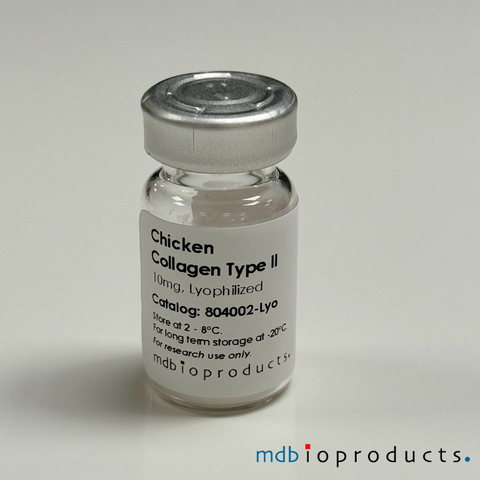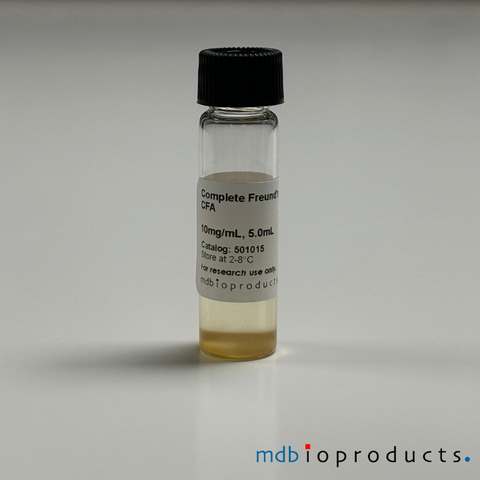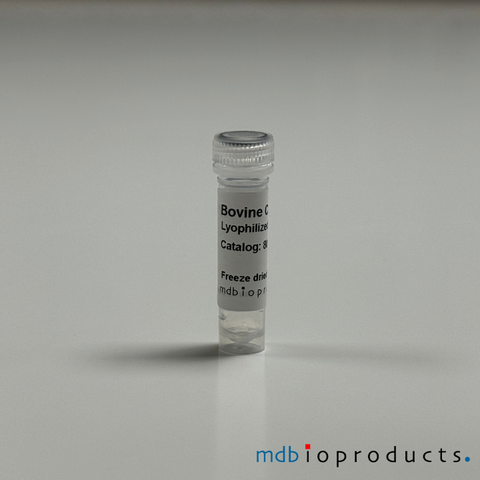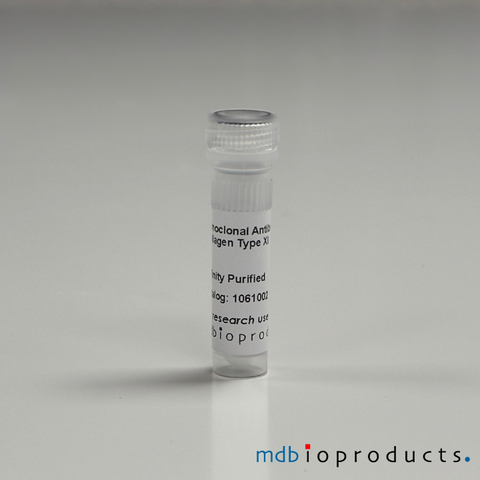Collagen Type II, Chicken, Soluble, 2 mg/mL
Highest quality (>99%) Collagen type II (CII) protein, purified from chicken sternum, for the induction of arthritis in the Collagen-Induced Arthritis (CIA) model. Soluble 10 mg (2 mg/mL). Type II...
Protein
804002-sol
Highest quality (>99%) Collagen type II (CII) protein, purified from chicken sternum, for the induction of arthritis in the Collagen-Induced Arthritis (CIA) model. Soluble 10 mg (2 mg/mL).
Type II collagen (CII) is a fibrillar collagen that is primarily located in cartilage tissue. The major molecular form of collagen in cartilage is type II collagen. Type II collagen is also located in the vitreous humor of the eye, the inner ear, the nose, and the intervertebral discs of the spine. The function of type II collagen is to provide tensile strength and give cartilage the ability to resist shearing forces. Mutations of the COL2A1 gene affect the synthesis of type II collagen and cause chondrodysplasias. This is characterized by abnormal cartilage that leads to bone and joint deformities. The degradation of collagen type II is an early indicator of osteoarthritis.
Type II Collagen and Adjuvent Susceptibility to CIA is linked to MHC class II molecules and is dependent upon the species of type II collagen used for immunization. Various species of highly purified Type II Collagen are supplied lyophilized and in solution for use in the induction of arthritis in vivo.
Symbols/Related Terms:
- COL2A1
- pro-alpha 1(II) chain
- Achondrogenesis
- Hypochondrogenesis
- Spondyloepiphyseal dysplasia
- Osteoarthritis (OA)
- Collagen Induced Arthritis (CIA)
References/Citations:
Lu, C. L., Ortmeier, S., Brudvig, J., Moretti, T., Cain, J., Boyadjiev, S. A., ... & Kim, J. (2022). Collagen has a unique SEC24 preference for efficient export from the endoplasmic reticulum. Traffic, 23(1), 81-93.
Li, L., Freitag, J., Asbrand, C., Munteanu, B., Wang, B. T., Zezina, E., ... & Biesemann, N. (2022). Multi-omics profiling of collagen-induced arthritis mouse model reveals early metabolic dysregulation via SIRT1 axis. bioRxiv.
Wang, Y., Pan, P., Khan, A., Çil, Ç., & Pineda, M. A. (2022). Synovial Fibroblast Sialylation Regulates Cell Migration and Activation of Inflammatory Pathways in Arthritogenesis. Frontiers in Immunology, 13.
Gilis, E., Gaublomme, D., Staal, J., Venken, K., Dhaenens, M., Lambrecht, S., ... & Dumas, E. (2019). Deletion of Mucosa-Associated Lymphoid Tissue Lymphoma Translocation Protein 1 in Mouse T Cells Protects Against Development of Autoimmune Arthritis but Leads to Spontaneous Osteoporosis. Arthritis & Rheumatology, 71(12), 2005-2015.
Chuang, H. C., Chen, Y. M., Chen, M. H., Hung, W. T., Yang, H. Y., Tseng, Y. H., & Tan, T. H. (2019). AhR–ROR-γt complex is a therapeutic target for MAP4K3/GLKhighIL-17A high subpopulation of systemic lupus erythematosus. The FASEB Journal, 33(10), 11469-11480.
Moschovakis, G. L., Bubke, A., Friedrichsen, M., Ristenpart, J., Back, J. W., Falk, C. S., ... & Förster, R. (2018). The chemokine receptor CCR7 is a promising target for rheumatoid arthritis therapy. Cellular & molecular immunology
Vierboom, M. P., Breedveld, E., Keehnen, M., Klomp, R., & Bakker, J. (2017). Pain Relief in Nonhuman Primate Models of Arthritis. In Inflammation (pp. 411-417). Humana Press, New York, NY
Kurowska-Stolarska, M., Alivernini, S., Melchor, E. G., Elmesmari, A., Tolusso, B., Tange, C., ... & Stewart, L. (2017). MicroRNA-34a dependent regulation of AXL controls the activation of dendritic cells in inflammatory arthritis. Nature communications, 8, 15877.
Moschovakis, G. L., Bubke, A., Friedrichsen, M., Falk, C. S., Feederle, R., & Förster, R. (2017). T cell specific Cxcr5 deficiency prevents rheumatoid arthritis. Scientific Reports, 7(1), 8933.
Verheul, M. K., Vierboom, M. P., Bert, A., Toes, R. E., & Trouw, L. A. (2017). Anti-carbamylated protein antibodies precede disease onset in monkeys with collagen-induced arthritis. Arthritis research & therapy, 19(1), 246.
Athari, S. K., Poirier, E., Biton, J., Semerano, L., Hervé, R., Raffaillac, A., ... & Boissier, M. C. (2016). Collagen-induced arthritis and imiquimod-induced psoriasis develop independently of interleukin-33. Arthritis research & therapy, 18(1), 143.
Biton, J., Athari, S. K., Thiolat, A., Santinon, F., Lemeiter, D., Hervé, R., ... & Girard, J. P. (2016). In vivo expansion of activated Foxp3+ regulatory T cells and establishment of a type 2 immune response upon IL-33 treatment protect against experimental arthritis. The Journal of Immunology, 1502124.
Vierboom, M. P. M., Breedveld, E., Kap, Y. S., Mary, C., Poirier, N., 't Hart, B. A., & Vanhove, B. (2016). Clinical efficacy of a new CD28‐targeting antagonist of T cell co‐stimulation in a non‐human primate model of collagen‐induced arthritis. Clinical & Experimental Immunology, 183(3), 405-418.
Van Roy, M., Ververken, C., Beirnaert, E., Hoefman, S., Kolkman, J., Vierboom, M., ... & Jacobs, S. (2015). The preclinical pharmacology of the high affinity anti-IL-6R Nanobody® ALX-0061 supports its clinical development in rheumatoid arthritis. Arthritis research & therapy, 17(1), 135.
Vicente, R., Quentin, J., Mausset-Bonnefont, A. L., Chuchana, P., Martire, D., Cren, M., ... & Louis-Plence, P. (2015). Nonclassical CD4+ CD49b+ regulatory T cells as a better alternative to conventional CD4+ CD25+ T cells to dampen arthritis severity. The Journal of Immunology, 1501069.
Perez, J., Dansou, B., Hervé, R., Levi, C., Tamouza, H., Vandermeersch, S., ... & Boissier, M. C. (2015). Calpains released by T lymphocytes cleave TLR2 to control IL-17 expression. The Journal of Immunology, 1500749.
Lindh, I., Snir, O., Lönnblom, E., Uysal, H., Andersson, I., Nandakumar, K. S., ... & Holmdahl, R. (2014). Type II collagen antibody response is enriched in the synovial fluid of rheumatoid joints and directed to the same major epitopes as in collagen induced arthritis in primates and mice. Arthritis research & therapy, 16(4), R143.
Roy, L. D., Sahraei, M., Schettini, J. L., Gruber, H. E., Besmer, D. M., & Mukherjee, P. (2014). Systemic neutralization of IL-17A significantly reduces breast cancer associated metastasis in arthritic mice by reducing CXCL12/SDF-1 expression in the metastatic niches. BMC cancer, 14(1), 225.
Chen, Y. M., Chuang, H. C., Lin, W. C., Tsai, C. Y., Wu, C. W., Gong, N. R., ... & Chen, D. Y. (2013). Germinal Center Kinase–like Kinase Overexpression in T Cells as a Novel Biomarker in Rheumatoid Arthritis. Arthritis & Rheumatism, 65(10), 2573-2582.
Marenzana, M., Vugler, A., Moore, A., & Robinson, M. (2013). Effect of sclerostin-neutralising antibody on periarticular and systemic bone in a murine model of rheumatoid arthritis: a microCT study. Arthritis Res Ther, 15(5), R125.
Iqbal, A. J., Cooper, D., Vugler, A., Gittens, B. R., Moore, A., & Perretti, M. (2013). Endogenous galectin-1 exerts tonic inhibition on experimental arthritis. The Journal of Immunology, 191(1), 171-177.
Vierboom, M., Breedveld, E., Kondova, I., & 't Hart, B. (2010). Collagen-induced arthritis in common marmosets: a new nonhuman primate model for chronic arthritis. Arthritis Research and Therapy, 12(5), R200.
Asquith, D. L., Miller, A. M., Hueber, A. J., Liew, F. Y., Sattar, N., & McInnes, I. B. (2010). Apolipoprotein E–deficient mice are resistant to the development of collagen‐induced arthritis. Arthritis & Rheumatism, 62(2), 472-477.
Pufe, T., Petersen, W., Kurz, B., Tsokos, M., Tillmann, B., & Mentlein, R. (2003). Mechanical factors influence the expression of endostatin—an inhibitor of angiogenesis—in tendons. Journal of orthopaedic research, 21(4), 610-616.
Bäcklund, J., Treschow, A., Bockermann, R., Holm, B., Holm, L., Issazadeh‐Navikas, S., ... & Holmdahl, R. (2002). Glycosylation of type II collagen is of major importance for T cell tolerance and pathology in collagen‐induced arthritis. European journal of immunology, 32(12), 3776-3784.
Apolipoprotein E-deficient mice are resistant to the development of collagen-induced arthritis.
Asquith DL, Miller AM, et al. Arthritis Rheum. 2010 Feb; 62(2):472-7.Reversible changes in serum immunoglobulin galactosylation during the immune response and treatment of inflammatory autoimmune arthritis.Van Beneden K, et al. Annals of the rheumatic diseases. 2009; 68(8):1360-5.
































